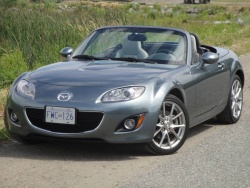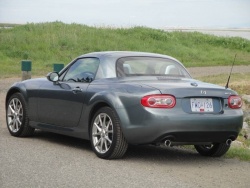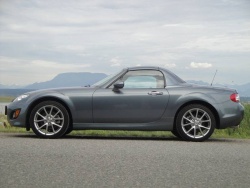 2011 Mazda MX-5 Special Version. Click image to enlarge |
| Related links More Mazda MX-5 reviews on Autos.caManufacturer’s web site Mazda Canada |
Review and photos by Greg Wilson
Photo Gallery:
2011 Mazda MX-5
What’s so special about the new-for-2011 Mazda MX-5 Special Version? Starting at $40,695, it’s now the most exclusive and most expensive model in the MX-5 hierarchy, which starts with the GX ($28,995) which has a black vinyl convertible top and a five-speed manual transmission; the GS ($33,495) with a black cloth top and six-speed manual transmission; and the GT ($39,995) with a standard body-coloured power retractable hardtop (PRHT) and six-speed manual transmission.
The MX-5 Special Version comes in a unique and rather alluring Newport Slate Metallic exterior colour, and unique tinted grey “semi-aniline” leather seats and trim, a leather-wrapped steering wheel with grey stitching, and a hand brake lever with grey stitching. (GT models offer a choice of Black, Dune Beige, or Havana Brown leather.) The MX-5 Special Version also features unique chrome rings around the gauges and chrome air vent bezels (replacing the silver trim on GT models).
 2011 Mazda MX-5 Special Version. Click image to enlarge |
Other than that, the Special Version is equipped similarly to the GT model with a standard power retractable hardtop, 167-hp 2.0-litre DOHC 16-valve four-cylinder engine with variable valve timing, six-speed manual transmission, low profile 17-inch tires, xenon headlights, fog lights, front strut cross brace, limited slip differential, Bilstein shocks, dynamic stability control, keyless entry and ignition start, heated seats, automatic climate control, Bose audio system with seven speakers, six-disc CD changer, Sirius satellite radio, auxiliary jack, and Bluetooth hands-free phone. A navigation system isn’t available.
The only option on the MX-5 Special Version is a six-speed automatic transmission with a lock-up torque converter and a manual shift mode with shift paddles behind the steering wheel ($1,200). This transmission is also optional on the GS and GT models. When equipped with the automatic transmission, MX-5s have a slight drop in horsepower, from 167 @ 7,000 rpm to 158 @ 6,700 rpm, but torque remains the same at 140 lb.-ft. at 5,000 rpm. As well, when the six-speed automatic transmission is ordered, the stiffer sport suspension with Bilstein shock absorbers and rear limited slip differential are deleted from the standard equipment list.
  2011 Mazda MX-5 Special Version. Click image to enlarge |
MX-5s equipped with the automatic transmission burn a little more gas than the manual transmission models: they’re rated at 10.1 L/100 km city and 7.2 L/100 km hwy, compared to 9.7/7.1 city/hwy for the six-speed manual model (Natural Resources Canada). My onboard fuel consumption display was showing an average of 10.9 L/100 km in mostly urban driving. All MX-5’s require Premium gasoline because of the engine’s high 10.8:1 compression ratio.
With nine fewer horses and a 37 kg weight gain over MX-5’s with a soft top, the automatic-equipped MX-5 Special Version doesn’t feel quite as quick as the manual soft top model which can reach 100 km/h in just 7.8 seconds. However, the Special Version’s slightly less choppy ride enhances ride comfort while its smooth-changing automatic transmission makes it easier to drive around town – there’s no need to be constantly depressing the clutch pedal and shifting gears at every traffic light. If drivers want more excitement, they can tap the shift lever over to the left gate and push ahead to shift down or push back to shift up; alternatively, the driver can use the “paddles” behind the steering wheel: pull the left or right paddle with your forefingers to shift up, and push the left or right buttons with your thumb to shift down. Shift times are quick, but I didn’t find this system as easy to use as some others where the left paddle is used to shift down and the right paddle to shift up. As with other manumatics, if the driver fails to shift down as the car slows, the manual mode will do it automatically, and if they fail to shift up, a rev limiter prevents engine damage. Even in Drive, the driver can shift manually but the transmission will revert to automatic mode after five seconds.
I suspect that anyone who wants to shift manually will buy the MX-5 with the six-speed manual transmission. The automatic is for people who don’t want to shift.
On the highway, the MX-5 tracks well with engine turning over just 2,200 r.p.m. in top gear at 100 km/h.
Though its suspension is not as stiff as the manual transmission model, an MX-5 with the automatic transmission is no boulevard cruiser – the MX-5 automatic is still an agile, flat-handling sports car with tremendous handling and quick but rather firm steering (r.p.m. sensitive). Its short wheelbase, tight turning circle (9.4 m/31 ft.), fully independent suspension and standard 205/45R17 all-season tires contribute to nimble-footed agility, manoeuvrability and extremely high handling limits, while its light curb weight (1159 kg/2555 lbs) and big disc brakes haul it down in impossibly short braking distances.
   2011 Mazda MX-5 Special Version. Click image to enlarge |
As a lightweight, rear-wheel drive sports car with a 50/50 front/rear weight distribution, oversteer in wet or icy conditions is a concern. The MX-5, perhaps more than most other cars, benefits from standard Dynamic Stability Control that helps prevent loss of control when cornering by selectively braking different wheels; and traction control that minimizes drive-wheel spin. These automatic safety systems compensate for poor road conditions, poor drivers, or both. Still, I think it would have been better if Mazda hadn’t deleted the rear limited slip differential which can improve traction when one rear wheel is on a slippery surface and the other isn’t.
The MX-5’s power retractable hardtop is a neat piece of engineering that retracts in only twelve seconds. After putting the transmission in Park or Neutral, the driver releases a latch in the centre of the windshield header and presses a button on the instrument panel. Neither the brake pedal or handbrake need to be activated before opening the top. It folds in two pieces, and when retracted, a body-coloured tonneau partially covers it, but not completely. As a result, the design includes some crevices where dust and dirt can collect if the car is left open in a parking lot on a windy day.
The retractable top folds into the same space as the soft convertible top does, so the trunk is the same size of 150 litres (5.6 cu. ft.). It is a small trunk, but then again, it’s a small sports car where cargo capacity is a secondary consideration to performance and looks.
When raised, the body-coloured top looks quite handsome but gives the MX-5 a unique profile that’s more rounded than the soft-top MX-5. Personally, I think the old removeable hardtops looked better in profile, but it’s likely that Mazda engineers had to make some compromises in the PRHT design in order to get the folding top to fit into the small space behind the seats.
With the top up, the driver’s rear visibility is quite good, partly because of the rear window is large and partly because it’s only inches away from the driver’s head. On the road, the hard convertible top shuts out road and traffic noise better than the soft top, reduces wind noise, and the top doesn’t flap around in the wind. It also eliminates the possibility of thieves cutting open the soft top to gain entry.
  2011 Mazda MX-5 Special Version. Click image to enlarge |
Behind the seats are silver-coloured hoops. These are just for looks; they’re not designed for rollover protection. Between them is a folding windblocker that is supposed to reduced wind buffeting, but I found its effects to be minimal.
The MX-5’s cabin is snug, especially if you’re a larger adult. Driver and passenger sit nestled between a high centre console and door which provide bracing during high-spirited cornering. Controls are well laid out with the exception of the radio’s grey LCD display which often gets lost in the Sun’s glare. The MX-5 Special Version’s standard Bose audio system with five speakers and two tweeters is a lot of stereo for a little car but makes the drive more enjoyable with its impressive sound. This audio system includes six-disk CD changer, Sirius satellite radio and an auxiliary input, however I didn’t see a USB port. Audio, cruise and Bluetooth functions can be controlled with steering wheel buttons. The steering wheel tilts but unfortunately doesn’t telescope.
The Special Version’s unique grey leather seats are comfortable on long drives, offer good side support and integral head restraints, and the driver’s seat has a manual height adjuster. Both seats have heaters with five temperature settings, and the automatic climate control features manual ventilation settings specifically designed for driving with the top down. Special air vents below the round ones on the dash direct air to the middle regions of the body to keep them warm or cool, as the case may be.
There are two cupholders in the centre console, hidden by a sliding cover, and one in each door. With the automatic transmission, it’s certainly easier to keep the coffee from spilling when there’s no risk of striking the cup when shifting gears. For storage, there is a small bin between and behind the seats (where the fuel release lever is hidden), a front glovebox, and a coin tray near the driver’s door.
Our 2011 MX-5 Special Version test car with the optional six-speed automatic topped out at over $43,000 including a rather hefty $1,695 Freight and PDI charge. That’s a lot of money for a compact sports car, but consider that sports cars like the BMW Z4 and Mercedes-Benz SLK start at $54,300 and $59,900 respectively.
The fact is, the Mazda MX-5 is a unique rear-wheel drive sports car that has no direct competitors; and for those who want something extra special with all the toys, the 2011 MX-5 Special Version is unique among MX-5s.
Verdict
With a unique exterior colour and unique leather interior, the top-of-the-line 2011 MX-5 Special Version is basically a gussied up version of the GT. City dwellers who don’t like the extra work of a manual transmission and clutch will enjoy the optional six-speed automatic with paddle shifters.
|
Pricing: 2011 Mazda MX-5 Special Version
|











